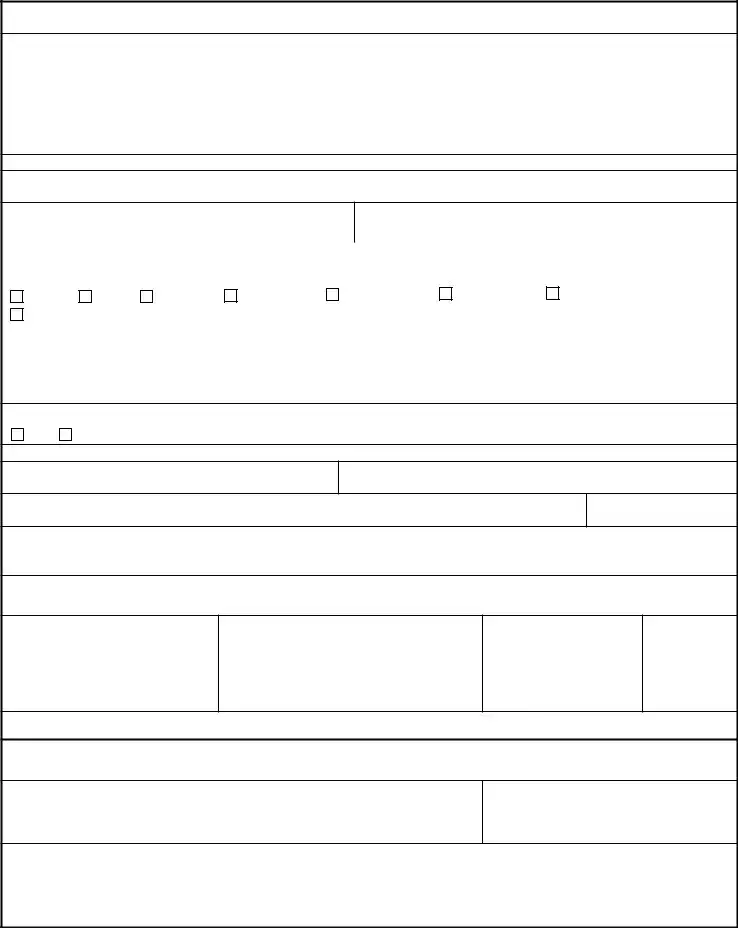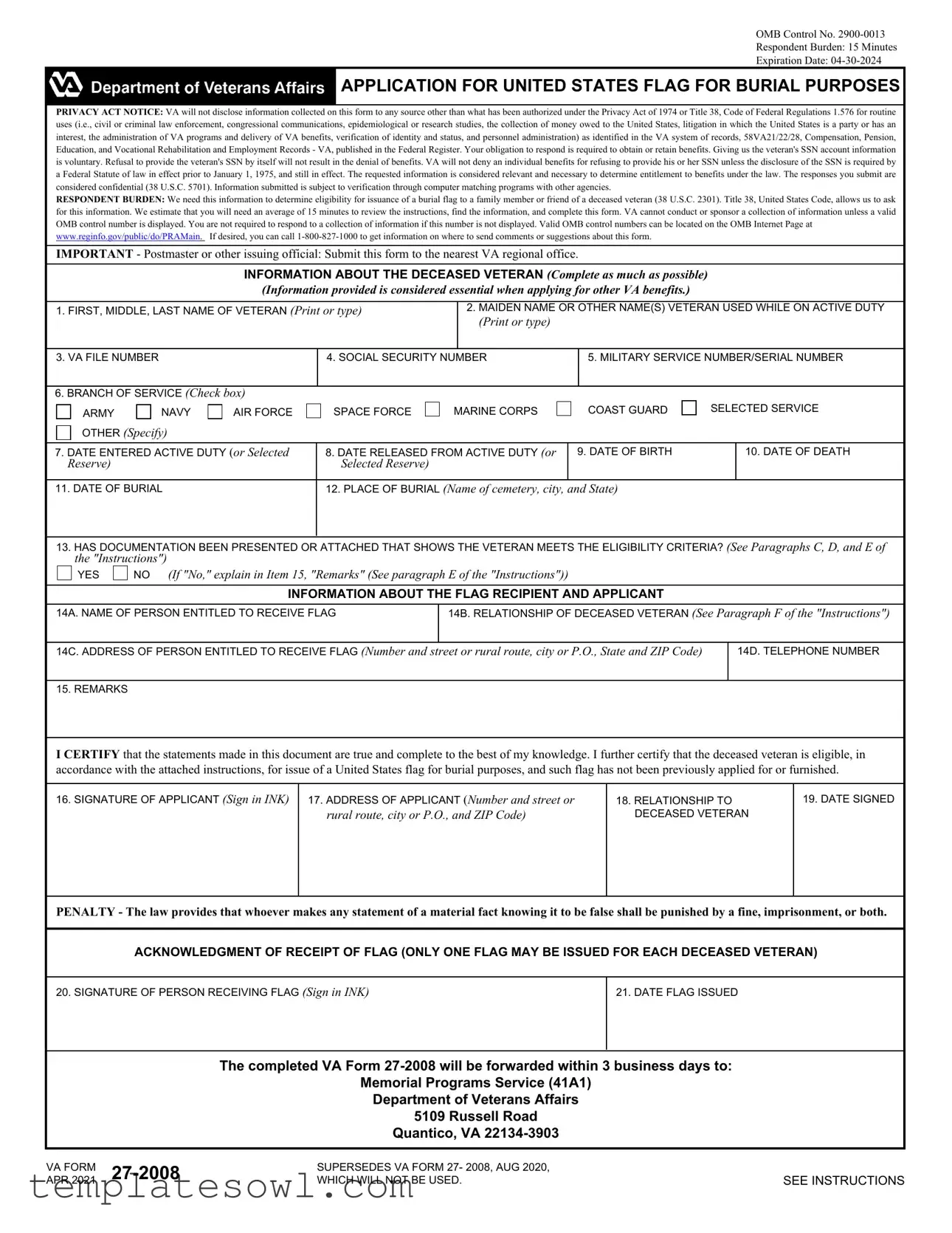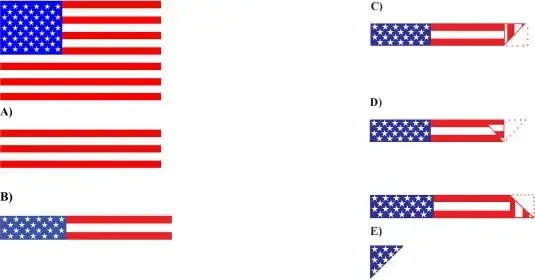
OMB Control No. 2900-0013
Respondent Burden: 15 Minutes
Expiration Date: 04-30-2024
 APPLICATION FOR UNITED STATES FLAG FOR BURIAL PURPOSES
APPLICATION FOR UNITED STATES FLAG FOR BURIAL PURPOSES
PRIVACY ACT NOTICE: VA will not disclose information collected on this form to any source other than what has been authorized under the Privacy Act of 1974 or Title 38, Code of Federal Regulations 1.576 for routine uses (i.e., civil or criminal law enforcement, congressional communications, epidemiological or research studies, the collection of money owed to the United States, litigation in which the United States is a party or has an interest, the administration of VA programs and delivery of VA benefits, verification of identity and status, and personnel administration) as identified in the VA system of records, 58VA21/22/28, Compensation, Pension, Education, and Vocational Rehabilitation and Employment Records - VA, published in the Federal Register. Your obligation to respond is required to obtain or retain benefits. Giving us the veteran's SSN account information is voluntary. Refusal to provide the veteran's SSN by itself will not result in the denial of benefits. VA will not deny an individual benefits for refusing to provide his or her SSN unless the disclosure of the SSN is required by a Federal Statute of law in effect prior to January 1, 1975, and still in effect. The requested information is considered relevant and necessary to determine entitlement to benefits under the law. The responses you submit are considered confidential (38 U.S.C. 5701). Information submitted is subject to verification through computer matching programs with other agencies.
RESPONDENT BURDEN: We need this information to determine eligibility for issuance of a burial flag to a family member or friend of a deceased veteran (38 U.S.C. 2301). Title 38, United States Code, allows us to ask for this information. We estimate that you will need an average of 15 minutes to review the instructions, find the information, and complete this form. VA cannot conduct or sponsor a collection of information unless a valid OMB control number is displayed. You are not required to respond to a collection of information if this number is not displayed. Valid OMB control numbers can be located on the OMB Internet Page at www.reginfo.gov/public/do/PRAMain. If desired, you can call 1-800-827-1000 to get information on where to send comments or suggestions about this form.
IMPORTANT - Postmaster or other issuing official: Submit this form to the nearest VA regional office.
INFORMATION ABOUT THE DECEASED VETERAN (Complete as much as possible)
(Information provided is considered essential when applying for other VA benefits.)
1. FIRST, MIDDLE, LAST NAME OF VETERAN (Print or type)
2.MAIDEN NAME OR OTHER NAME(S) VETERAN USED WHILE ON ACTIVE DUTY
(Print or type)
3. VA FILE NUMBER |
|
|
4. SOCIAL SECURITY NUMBER |
|
5. MILITARY SERVICE NUMBER/SERIAL NUMBER |
|
|
|
|
|
|
|
6. BRANCH OF SERVICE (Check box) |
|
|
|
|
|
|
ARMY |
NAVY |
AIR FORCE |
SPACE FORCE |
MARINE CORPS |
|
COAST GUARD |
SELECTED SERVICE |
OTHER (Specify) |
|
|
|
|
|
|
|
7. DATE ENTERED ACTIVE DUTY (or Selected |
8. DATE RELEASED FROM ACTIVE DUTY (or |
9. DATE OF BIRTH |
|
10. DATE OF DEATH |
Reserve) |
|
|
Selected Reserve) |
|
|
|
|
|
|
|
|
|
|
|
|
11. DATE OF BURIAL |
|
12. PLACE OF BURIAL (Name of cemetery, city, |
and State) |
|
|
|
|
|
|
|
|
|
|
|
13.HAS DOCUMENTATION BEEN PRESENTED OR ATTACHED THAT SHOWS THE VETERAN MEETS THE ELIGIBILITY CRITERIA? (See Paragraphs C, D, and E of the "Instructions")
NO (If "No," explain in Item 15, "Remarks" (See paragraph E of the "Instructions"))
INFORMATION ABOUT THE FLAG RECIPIENT AND APPLICANT
14A. NAME OF PERSON ENTITLED TO RECEIVE FLAG
14B. RELATIONSHIP OF DECEASED VETERAN (See Paragraph F of the "Instructions")
14C. ADDRESS OF PERSON ENTITLED TO RECEIVE FLAG (Number and street or rural route, city or P.O., State and ZIP Code)
15. REMARKS
I CERTIFY that the statements made in this document are true and complete to the best of my knowledge. I further certify that the deceased veteran is eligible, in accordance with the attached instructions, for issue of a United States flag for burial purposes, and such flag has not been previously applied for or furnished.
16. SIGNATURE OF APPLICANT (Sign in INK)
17.ADDRESS OF APPLICANT (Number and street or rural route, city or P.O., and ZIP Code)
18.RELATIONSHIP TO DECEASED VETERAN
PENALTY - The law provides that whoever makes any statement of a material fact knowing it to be false shall be punished by a fine, imprisonment, or both.
ACKNOWLEDGMENT OF RECEIPT OF FLAG (ONLY ONE FLAG MAY BE ISSUED FOR EACH DECEASED VETERAN)
20. SIGNATURE OF PERSON RECEIVING FLAG (Sign in INK)
The completed VA Form 27-2008 will be forwarded within 3 business days to:
Memorial Programs Service (41A1)
Department of Veterans Affairs
5109 Russell Road
Quantico, VA 22134-3903
VA FORM |
27-2008 |
SUPERSEDES VA FORM 27- 2008, AUG 2020, |
SEE INSTRUCTIONS |
APR 2021 |
WHICH WILL NOT BE USED. |
ISSUING OFFICIAL WILL DETACH THIS SHEET AND PRESENT IT TO THE RECIPIENT OF THE FLAG
USE OF THE FLAG
1.This flag is issued on behalf of the Department of Veterans Affairs to honor the memory of one who has served our country.
2.When used to drape the casket, the flag should be placed as follows:
(a)Closed Casket - When the flag is used to drape a closed casket, it should be so placed that the union (blue field) is at the head and over the left shoulder of the deceased.
(b)Half Couch (Open) - When the flag is used to drape a half-couch casket, it should be placed in three layers to cover the closed half of the casket in such a manner that the blue field will be the top fold, next to the open portion of the casket on the deceased's left.
(c)Full Couch (Open) - When the flag is used to drape a full-couch casket, it should be folded in a triangular shape and placed in the center part of the head panel of the casket cap, just above the left shoulder of the deceased.
3.During a military commitment ceremony, the flag which was used to drape the casket is held waist high over the grave by the pallbearers and, immediately after the sounding of "Taps," is folded in accordance with the illustration below.
4.Folding the flag (see illustration below):
5.The flag should not be lowered into the grave or allowed to touch the ground. When taken from the casket, it should be folded as shown (see illustration).
6.The flag should form a distinctive feature of the ceremony of the unveiling of a statue or monument, but it should never be used as a covering for the statue or monument.
7.The flag should never be fastened, displayed, used, or stowed in such a manner as will permit it to be easily torn, soiled, or damaged in any way.
8.The flag should never have placed upon it, nor any part of it, nor attached to it, any mark, insignia, letter, word, figure, design, picture, or drawing of any nature.
9.The flag should never be used as a receptacle for receiving, holding, carrying, or delivering anything.
10.The flag, when badly worn, torn, or soiled should no longer be publicly displayed, but privately destroyed by burning in such a manner as to convey no suggestion of disrespect or irreverence.
CORRECT METHOD OF FOLDING THE UNITED STATES FLAG
(A)Straighten out the flag to full length and fold lengthwise once, folding the lower striped section of the flag over the blue field.
(B)Fold the flag lengthwise a second time to meet the open edge, making sure that the union of stars on the blue field remains outward in full view.
(C)A triangular fold is then started by bringing the striped corner of the folded edge to the open edge.
(D)The outer point is then turned inward, parallel with the open edge to form a second triangle.
(E)The diagonal or triangular folding is continued toward the blue union until the end is reached, with only the blue showing and the form being that of a cocked (three corner) hat.
VA FORM 27-2008, APR 2021 |
Page 3 |


 APPLICATION FOR UNITED STATES FLAG FOR BURIAL PURPOSES
APPLICATION FOR UNITED STATES FLAG FOR BURIAL PURPOSES